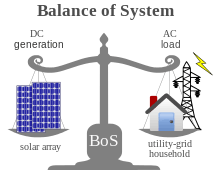Balance of system

The balance of system (BOS) encompasses all components of a photovoltaic system other than the photovoltaic panels.[1] This includes wiring, switches, a mounting system, one or many solar inverters, a battery bank and battery charger.
Other optional components include, renewable energy credit revenue-grade meter, maximum power point tracker (MPPT), GPS solar tracker, Energy management software, solar concentrators, solar irradiance sensors, anemometer, or task-specific accessories designed to meet specialized requirements for a system owner. In addition, CPV systems require optical lenses or mirrors and sometimes a cooling system.
In addition, ground-mounted, large photovoltaic power station require equipment and facilities, such as grid connections, office facilities, and concrete.[2] Land is sometimes included as part of the BOS as well.
References
- ↑ "Balance of System". Solar Energy Technologies Program. U.S. Department of Energy. 5 January 2006. Archived from the original on 4 May 2008. Retrieved 7 May 2008.
- ↑ "Life Cycle Inventories and Life Cycle Assessments of Photovoltaic Systems". IEA-PVPS (published 13 March 2015). January 2015. p. 18. Archived from the original on 22 March 2015.